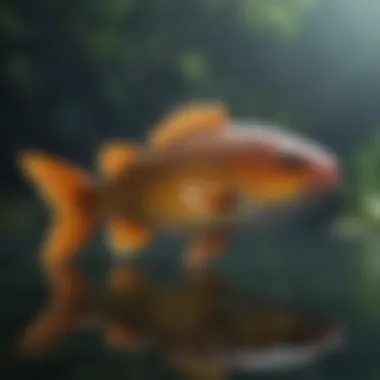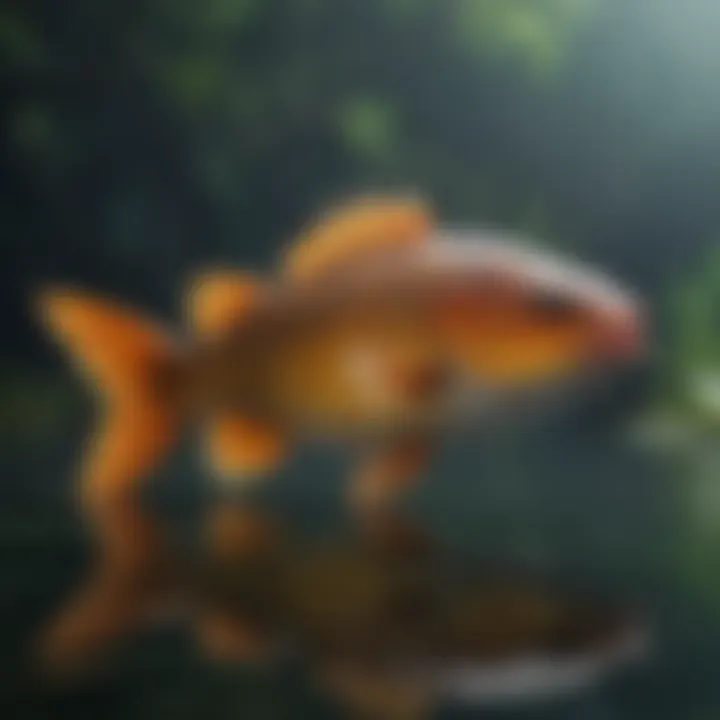Exploring the Rich Diversity of Lake Fishes


Overview of the Topic
Freshwater lakes present a microcosm of biodiversity, an intricate web of life where lake fishes play a pivotal role. These species are more than just inhabitants of these aquatic environments; they are integral to the health of the ecosystem, influencing everything from nutrient cycling to trophic interactions. This article seeks to shine a light on the diverse world of lake fishes, exploring their habitats, behaviors, and interactions with both the ecosystem and humans.
The significance of lake fishes goes beyond their presence in the water. They serve as indicators of ecological balance and health. Profoundly tied to the cultural, economic, and recreational activities of communities, these species are, in many ways, mirrors reflecting the state of our environment. As many species face increasing threats, understanding their biology and ecology becomes vital.
Current Status and Challenges
The current state of lake fish populations is a mixed bag. Some species, like the common carp, have adapted well to human-altered environments, while others, such as the native whitefish, face dire straits. Factors contributing to these disparities include:
- Pollution: Contaminants from agriculture and industry seep into lakes, affecting water quality and fish health.
- Overfishing: Unsustainable fishing practices can lead to drastic population declines.
- Invasive Species: Non-native species can disrupt local ecosystems, out-competing native fishes for resources.
- Habitat Loss: Development along shorelines can destroy essential spawning and feeding habitats.
"Lake fish are like the sentinels of our freshwater ecosystems. Their decline marks a red flag for broader ecological issues."
These challenges paint a stark picture of the future of lake fish, but solutions do exist. Amidst these threats, a concerted effort toward understanding and conservation can make a difference.
Sustainable Solutions
Addressing the challenges faced by lake fish involves implementing sustainable practices that balance human activities with ecological health. Some solutions worth noting include:
- Community-Based Fisheries Management (CBFM): Local communities often hold the knowledge essential for managing fish stocks sustainably. Recognizing their role can lead to more effective conservation efforts.
- Habitat Restoration Projects: Initiatives to restore wetlands and natural shorelines aid in reclaiming lost breeding and foraging grounds.
- Gentler Fishing Practices: Regulations on fishing gear, catch limits, and seasonal restrictions can help alleviate pressure on vulnerable species.
Successful case studies abound. In lakes across North America, the reintroduction of native fish stocks alongside habitat improvement has shown encouraging results.
Impact and Importance
The implications of preserving lake fishes extend into ecosystems and human communities. Healthy fish populations contribute to:
- Biodiversity: Diverse species support broader ecological stability and resilience.
- Economic Value: Recreational fishing and tourism centered around fish species can boost local economies.
- Cultural Identity: Many communities depend on lake fishes for their heritage, lifestyle, and survival.
In a world facing climate change and environmental degradation, conserving lake fish is not merely an ecological concern but a critical piece in the puzzle of sustainable living for future generations.
Through this exploration, it is clear that lake fishes hold not just ecological value, but also cultural and economic significance. A holistic approach to their conservation can ensure that these vital aquatic resources are preserved for the enjoyment and benefit of all.
The Ecosystem of Freshwater Lakes
Freshwater lakes are fascinating environments, serving as vital ecosystems where diverse forms of life interact. These ecosystems encompass a complex balance that includes water chemistry, temperature variations, and light availability. In this exploration, we will break down these key elements to better understand their contributions to the overall health and function of lake aquatic systems.
Characteristics of Freshwater Environments
Water Chemistry
Understanding water chemistry is essential for comprehending how lakes function. It involves the composition of water in terms of its chemical constituents, such as pH levels, mineral concentrations, and dissolved gases. Changes in these factors can have profound influences on which organisms thrive in a given lake.
A key characteristic of water chemistry is pH levels, which typically range from 6 to 9 in healthy freshwater lakes. This range is a significant determinant of biological activity; for instance, most fish species prefer a near-neutral pH, which promotes their growth and reproduction. On the flip side, extreme deviations can be detrimental, impacting fish populations and biodiversity.
Moreover, nutrient concentrations point to another interesting feature. Lakes rich in nutrients, often termed eutrophic lakes, support an abundance of plant and animal life, but they can suffer from oxygen depletion—an unfortunate consequence when organic matter breaks down.
Temperature Variations
Temperature variations play a pivotal role in determining the types of species that inhabit a lake. Water temperature affects everything from fish metabolism to the growth rates of plants and algae. Generally, warmer water promotes higher activity levels in fish, as they are ectothermic animals.
A notable characteristic here is stratification, which occurs during warmer months. This phenomenon can lead to distinct layers within the water column. Unfortunately, it also creates challenges. The upper layer, or epilimnion, may become too warm for certain species, while the deeper hypolimnion remains cooler and potentially lower in oxygen, necessitating fishes’ movement.
Light Availability
Light availability is crucial as it influences photosynthesis in aquatic plants, which forms the base of the food web. The penetration of light into the water column defines the distribution of these photosynthetic organisms and impacts the overall productivity of the ecosystem.
One characteristic worth noting is that light availability is not uniform; it can vary based on depth, turbidity, and surface cover like algae or floating plants. High turbidity can limit light penetration and thus influence the kinds of fish that can thrive. Plants in the littoral zone, where light is abundant, are favored, making this area rich in biodiversity.
Role of Fishes in Lake Ecosystems
While there's a diverse array of organisms within the lake, fishes play a particularly significant role in maintaining the ecological balance. They influence nutrient cycling, contribute to various trophic levels, and form essential predator-prey relationships.
Trophic Levels
The concept of trophic levels helps us understand the position of fishes within the ecosystem. Fish species are categorized based on how they obtain their energy—whether they are primary producers, herbivores, or carnivores.
A critical characteristic of trophic levels is their interconnectedness. For example, small fishes serve as prey for larger carnivorous species, illustrating the flow of energy and nutrients from producers to top predators. Understanding these relationships can assist in conservation efforts, as disruptions at any level can ripple through the entire lake community.
Nutrient Cycling
Nutrient cycling refers to the movement and exchange of organic and inorganic matter back into the production of living matter. Fish contribute to nutrient cycling through their waste products, which are rich in nutrients that stimulate biological growth.
This feature adds tremendous value to the lake ecosystem. When fish die, their decomposing bodies release nutrients back into the ecosystem, providing a new cycle of life for plants and other organisms. Such contributions underscore the importance of maintaining healthy fish populations in lakes.
Predator-Prey Relationships
Predator-prey relationships are foundational within lake ecosystems, promoting biodiversity and preventing overpopulation of any one species. Different fish species often occupy specific niches, enabling them to coexist without directly competing for the same resources.
This dynamic ensures a balanced population throughout the ecosystem. When a predator’s population declines, for instance, prey species can surge, leading to overgrazing on aquatic plants. Conversely, in an ill-balanced ecosystem, too many predators can decimate prey populations, leading to dramatic ecological shifts.
Understanding these interactions is crucial for effective conservation strategies. Healthy predator-prey dynamics ensure the vibrancy of lake ecosystems and contribute to biodiversity.
As we proceed to explore the diversity of lake fish species, it’s essential to remember how these complex relationships and characteristics work together to create thriving ecosystems. Through this lens, we can better appreciate the vital roles fish play, not only as individual species but as integral participants in a larger ecological network.


Diversity of Lake Fish Species
The diversity of lake fish species plays a crucial role in establishing the health of freshwater ecosystems. Representing a wide array of behavioral, physiological, and ecological adaptations, these species contribute not only to the biological richness of lakes but also to the intricate web of life that sustains them. The many forms and functions of these species exhibit how versatility is key for ecological resilience and adaptability to environmental changes.
Recognizing this diversity allows us to appreciate the complexity of lake ecosystems, which ranges from enhancing nutrient cycling to maintaining food webs. Furthermore, understanding these unique fish species helps in realizing their impact on conservation efforts and sustainable practices.
Categorizing Lake Fish
Freshwater vs. Marine Species
The distinction between freshwater and marine species lies primarily in their habitat. Freshwater fish thrive in water bodies with low salinity, like lakes, rivers, and ponds. On the contrary, marine species inhabit oceans and seas where salinity is considerably higher. This characteristic affects their physiology, reproduction, and behavior.
A key takeaway here is the adaptability of freshwater fish to varying environmental conditions found in these lakes. While many marine species possess traits that enable them to live in stable, saline environments, freshwater species often exhibit remarkable resilience to fluctuating pH levels and temperature variations. However, they are also more susceptible to pollution and habitat destruction, making their conservation vital.
Nomenclature and Taxonomy
The organization of lake fish species through nomenclature and taxonomy is indispensable for ecological studies and conservation efforts. By assigning scientific names based on unique characteristics, we can classify and understand the relationships between various species. This classification is beneficial because it aids researchers in tracking population changes, understanding ecosystems, and strategizing conservation.
One unique aspect of taxonomy is the use of phylogenetic trees—it showcases the evolutionary relationship among species. This approach offers insights into biodiversity and can help identify highly specialized fish, which tend to be more vulnerable to extinction.
Endemic Species in Isolated Lakes
Isolated lakes often host endemic species—fish that are found nowhere else on Earth. These species have evolved in specific environmental conditions and have often developed unique adaptations. Recognizing their uniqueness is crucial because endemic species can serve as indicators of ecological health.
The plight of these lake fish starkly underscores the need for focused conservation efforts. However, their limited distribution makes them particularly prone to habitat loss and climate change. Protecting these endemic fish is not just about preserving a species; it’s also about maintaining the biodiversity that supports ecosystem stability.
Common Species in Local Lakes
Trout Species Overview
Trout species provide an excellent case study of lake fish diversity, with various types existing across the globe, particularly in cold-water lakes. Their adaptability has painted a picture of resilience, often thriving where conditions are optimal. Notably, the rainbow trout and brook trout are well-known for their striking colors and importance in both ecology and sport fishing, contributing significantly to local economies.
The unique feature of trout is their propensity for spawning in freshwater streams and tributaries, making connectivity between these environments crucial for their lifecycle. However, shifting climates pose challenges to these habitats, and conservation strategies must focus on maintaining clean, accessible spawning areas for the survival of these species.
Bass Varieties
Bass, another staple among freshwater fish, showcase a variety of species, particularly the largemouth and smallmouth bass. These fish are not only popular among anglers but also play a pivotal role in maintaining balanced aquatic food webs. Largemouth bass are known for their aggressive predation, while smallmouth bass thrive in different habitats and temperatures. Their differences underscore the adaptive strategies they utilize to exploit available resources.
The ecological role of bass cannot be understated. They contribute to the population control of smaller fish and help ensure a balanced ecosystem, but their presence can also indicate the overall health of the lake environment.
Panfish Characteristics
Panfish, encompassing species like bluegill, crappie, and perch, are fundamental to the lake's biodiversity. They serve as an important link in the food web, acting as prey for larger species while also contributing to nutrient cycling within the ecosystem. Their abundance and variety make them key indicators of lake health.
A unique feature of panfish is their adaptability to varied environments, which makes them highly resilient and prevalent in multiple aquatic systems. However, their populations can be sensitive to changes in water quality and biodiversity, highlighting the need for vigilant conservation practices.
Feeding Behaviors of Lake Fishes
Understanding the feeding behaviors of lake fishes offers valuable insights into their biological roles and ecological significance. These behaviors reveal not only how fish interact with their environment but also how they contribute to the delicate balance within freshwater ecosystems. Analyzing dietary preferences and foraging strategies enables conservationists, students, and environmentalists to address several considerations, such as habitat management and biodiversity conservation.
Dietary Preferences
Herbivorous vs. Carnivorous Fishes
When it comes to dietary choices, the distinction between herbivorous and carnivorous fishes is crucial. Herbivorous fishes primarily consume plant material, such as algae and aquatic vegetation. They play a significant role in controlling excess algae growth, maintaining water quality, and facilitating nutrient cycling. On the other hand, carnivorous fishes prey exclusively on other fish or invertebrates. This predation is vital in regulating fish population dynamics, thus achieving a balance in the community structure.
A critical aspect of herbivorous fishes pertains to their efficient conversion of plant matter into energy, which, in turn, supports larger predatory species. This characteristic makes them beneficiaries of the entire aquatic food web. Carnivorous species, characterized by sharp teeth and keen hunting instincts, exhibit important behaviors like chasing or ambushing their prey, showcasing the diverse adaptations in feeding practices. Both categories emphasize the versatile roles these fishes play in their ecosystems.
Omnivorous Species
Omnivorous fishes have a unique adaptability in that they consume both plant and animal matter. This dietary flexibility allows them to thrive in various environments, especially as food sources fluctuate. Omnivores often fill multiple ecological niches, making them pivotal for stabilizing the food web. For instance, species like common carp and bluegill adapt their feeding habits based on availability, whether it's leafy greens or smaller insects.
The key feature of omnivorous species is their ability to shift dietary preferences with seasonal changes or availability, which adds resilience to lake ecosystems. However, this opportunistic feeding can sometimes lead to overpopulation, complicating management efforts.
Impact of Seasonal Changes on Feeding
Seasonal changes have a profound influence on fish feeding behaviors, affecting their dietary choices and overall consumption patterns. As water temperatures fluctuate, fish metabolism tends to adjust accordingly. During warmer months, many species increase their feeding rates as food becomes abundant. Conversely, in colder months, their activity may decline significantly, leading to less foraging.
This seasonal variation illustrates the critical interdependence of climate and biological processes in freshwater lakes. For example, certain fishes might engage in spawning behaviors, triggering shifts in nutrient demand and distribution within the lake. Understanding these dynamics helps in anticipating the needs of specific species and aids in conserving their habitats effectively.
Foraging Strategies
Hunting Techniques
Hunting techniques among lake fishes vary widely, reflecting adaptations to their environment and prey availability. Some species rely on stealth and speed, while others may employ ambush tactics, waiting patiently for unsuspecting prey to come too close. Such strategies are not merely survival tools; they also dictate the ecological hierarchies within their habitats.
The efficiency of hunting techniques enhances the overall resilience of the ecosystem. For example, swift hunters like pike play a considerable role in controlling smaller fish populations. This predator-prey dynamic fosters a balanced aquatic community, emphasizing the importance of diverse hunting strategies across various species.
Use of Camouflage
Camouflage is a fascinating adaptation employed by several lake fishes to evade predators or to sneak up on prey. Fish like the stonecat or the northern pike rely on patterns and colors that mimic their surroundings, blending seamlessly into the environment. This ability not only supports personal survival but also maintains the ecological balance by allowing predatory fish to catch prey effectively.
The unique feature of camouflage impacts feeding success, directly correlating with species survival rates. However, it also presents a potential disadvantage, as fishes that rely too heavily on camouflage may struggle when environmental conditions shift, which can disrupt their feeding and breeding grounds.
Cooperative Foraging
Cooperative foraging is another intriguing strategy observed among certain lake fish species, where they work together to increase foraging success. Schools of fish, such as shad or cichlids, often collaborate, effectively partitioning their environment and enhancing their ability to locate food resources. This behavior illustrates the social dynamics within fish populations, emphasizing interdependence as a survival strategy.


The remarkable characteristic of cooperative foraging is that it maximizes feeding efficiency, allowing for larger catches and better resource management among competing fish. However, it can also present challenges, particularly if external factors like habitat loss or pollution disrupt their social structures.
"Feeding behaviors of lake fishes are not just about survival; they are integral to the health of aquatic ecosystems, influencing interactions, and maintaining balance."
Habitat Preferences of Lake Fishes
Understanding the habitat preferences of lake fishes is crucial for grasping how various species inhabit and utilize their environments. Different fish species show specific affinities to particular zones within lakes, shaped by factors like depth, light availability, and substrate composition. Recognizing these preferences not only enhances our knowledge of fish ecology but also informs conservation strategies and sustainable fishing practices. By delving into how habitat influences fish distribution, we can better appreciate the complex tapestry that defines lake ecosystems.
Lake Zones and Fish Distribution
Pelagic Zone
The pelagic zone, which refers to the open water column of lakes, plays a significant role in the ecosystem. Fish species like the lake trout often thrive in this area due to its abundant oxygen and nutrient flow. A key characteristic of this zone is its depth, which can stretch quite far in larger lakes. Because of this depth, the pelagic zone is predominantly cooler, making it an inviting habitat for species sensitive to warmer waters.
Its unique benefit lies in the availability of prey, such as zooplankton and small fish, catering to both carnivorous and omnivorous fish. However, navigating this zone may become challenging when discussing conservation efforts, particularly as pollution can impact water quality. Thus, monitoring the health of the pelagic zone remains vital for supporting fish populations.
Benthic Zone
The benthic zone is the lake's bottom area and is fundamentally important for many fish species. Here, fish such as catfish can be found digging into the substrate to forage for food like invertebrates and detritus. This zone is characterized by its rich sediment layer, which supports a diverse range of organisms, thus creating a complex food web.
One major consideration of the benthic zone is its role in nutrient cycling. It acts almost like a recycling center for organic matter, and its health is closely linked to the overall lake ecosystem. However, this zone can also suffer from issues like sedimentation, which can smother habitats and reduce biodiversity.
Littoral Zone
The littoral zone, situated near the shore, is often teeming with life. This zone's shallow waters create an ideal environment for spawning and nurturing young fish. Species such as bluegill and sunfish tend to be found in this area, as it is rich in vegetation, providing both cover and feeding opportunities.
The key characteristic of the littoral zone is its high levels of light penetration, which fosters the growth of aquatic plants. This unique feature not only provides habitat but also contributes to oxygen production. However, these zones are often the most vulnerable to human activities including development and pollution, which can disrupt the delicate balance within these critical habitats.
Environmental Factors Influencing Habitat
Ph Levels and Oxygenation
The acidity levels, or pH, of a lake's water play a pivotal role in shaping fish habitats. Most lake fishes thrive in ranges between 6.5 to 9.0 pH. Fish species, such as the yellow perch, display a clear preference for slightly acidic to neutral waters. What stands out about pH levels is how they can influence the types of invertebrates present, thereby indirectly affecting fish populations.
Oxygenation is equally crucial. Fish require dissolved oxygen for their survival, typically needing levels above 5 mg/L. Oxygen levels can fluctuate dramatically across different lake zones, which can be beneficial for some species but detrimental for others. Therefore, maintaining balanced pH and oxygenation is vital for the health of lake fish.
Temperature Impact
Temperature is another significant factor affecting fish habitats in lakes. Fish species are ectothermic, which means their body temperature adjusts to the surrounding water. Different species have varying temperature preferences; for instance, cold-water species like trout thrive in temperatures under 65°F, while warm-water species like bass prefer waters that exceed 70°F.
Changes in temperature can largely influence spawning cycles, migration patterns, and even predation rates. There's also a risk that rising temperatures, due to climate change, can push some species beyond their adaptability limits. Hence, tracking temperature shifts in lake habitats is vital for fish conservation efforts.
Depth and Light Penetration
The depth of a lake affects not just fish distribution but also the types of ecosystems that develop within it. Light penetration decreases as one moves deeper into the lake, impacting photosynthesis in aquatic plants. The interrelationship between depth and light penetration defines which species can occupy specific habitats.
For example, most fish that rely on photosynthetic algae must stay within zones where light can foster plant growth. However, deeper zone habitats may offer cooler water refuge during warm months or shelter from predators. This balance creates a dynamic interaction that is crucial in understanding the habitat preferences of lake fishes.
Conservation Challenges for Lake Fishes
Understanding the conservation challenges facing lake fishes is crucial. These challenges are not just local issues; they have far-reaching implications for biodiversity, ecosystem health, and even human communities that rely on freshwater resources for various needs. Fishes are often key indicators of ecosystem health. Their absence or decline signals a broader problem that is grasping the attention of conservationists, scientists, and policymakers alike. Therefore, addressing the threats to lake fishes allows us to maintain the balance of these complex ecosystems.
Threats to Freshwater Ecosystems
Freshwater ecosystems experience a variety of threats, primarily driven by human activities. Understanding these threats helps provide context to the conservation efforts.
Pollution Sources
Pollution in freshwater lakes often arises from agricultural runoff, industrial discharges, and poorly managed waste. Agricultural runoff introduces fertilizers and pesticides into the water, which lead to nutrient overload. This can cause algal blooms, choking lakes and creating dead zones where fishes cannot survive.
A key feature of pollution sources is their diversity; they can consist of many elements, including chemical waste and plastics. The unique aspect of pollution lies in its multifaceted nature, significantly affecting water quality and overall lake health. Its disadvantage includes the long-term repercussions that can often be irreversible, making pollution a pressing topic within conservation discussions.
Invasive Species
Invasive species pose a significant threat to native fish populations, often outcompeting them for resources. For instance, the introduction of the zebra mussel in the Great Lakes has disrupted local ecosystems. These mussels filter water and can drastically reduce phytoplankton, an essential food source for many small fish.
The characteristic of invasive species is their rapid reproduction and adaptability, which makes them problematic once established. They can lead to a decline in biodiversity, which poses a risk to the stability of the entire ecosystem. In this article, addressing invasive species serves as a spotlight on the importance of maintaining native species and their habitats.
Climate Change Effects
Climate change is arguably the most insidious threat affecting lake fishes. It leads to altered weather patterns, changes in temperature, and shifts in water levels. Fish species often require specific temperature ranges to thrive. As these ranges shift due to warming, endemic species are particularly vulnerable.
The key characteristic of climate change effects is their gradual yet continual impact. This results in long-term changes that are challenging to reverse. The unique feature here is the unpredictability; the consequences of climate change can escalate beyond anticipated levels, complicating conservation efforts. Understanding these effects is essential in crafting meaningful strategies for lake fish protection.
Conservation Efforts and Strategies
To combat the concerning trends, various conservation efforts and strategies have been put forward, aiming to mitigate threats and promote a sustainable future for lake fishes.
Protected Areas and Reserves
One significant aspect of conservation efforts is the establishment of protected areas and reserves. These designated areas can help safeguard the habitats of lake fishes from human disturbances, pollution, and other destructive activities. Their key characteristic is the legal protection they provide, allowing ecosystems to regenerate.
The unique feature of these areas lies in their ecological significance, as they serve as refuges for vulnerable species. However, one disadvantage can be the potential for misuse or relaxed regulations in some regions, which can compromise the effectiveness of these reserves in the long run.
Restoration Projects


Another avenue for supporting lake fishes is through restoration projects. These initiatives aim to revive damaged ecosystems, paving the way for fish populations to recover. The core idea is to recreate conditions that once supported a thriving aquatic community.
The advantage here is the potential for biodiversity enhancement, fostering stronger ecosystems and healthier fish stocks. However, restoration can be a challenging and costly effort, often requiring extensive research and community involvement to yield successful outcomes.
Community Engagement and Education
Lastly, community engagement and education are pivotal. Involving local communities not only raises awareness but also encourages sustainable practices that protect water resources. The key characteristic of such initiatives is their focus on empowering individuals to partake in conservation efforts.
The unique aspect of this strategy is its potential to change behaviors at a grassroots level, ensuring long-term support for conservation measures. However, overcoming apathy or resistance can be a significant hurdle, requiring consistent efforts from organizations and advocates.
"Protecting freshwater ecosystems is not just a choice, but a necessity for our collective future." - Environmental Advocate
Putting these conservation strategies into action is vital for sustaining lake fish populations and the broader ecosystems they inhabit. As challenges mount, awareness and concerted efforts can make all the difference.
The Importance of Sustainable Practices
In the realm of lake fisheries and ecosystems, sustainable practices play a pivotal role. Recognizing the intricate balance between human activity and nature is key to preserving these vital resources. The healthy existence of lake fishes relies on maintaining their environment, which can sometimes be overlooked amid the hustle and bustle of modern life. The essence of sustainability encompasses protecting fish populations, preserving habitats, and understanding human impacts.
Not only do sustainable practices ensure the longevity of fish populations, but they also contribute significantly to the overall health of lake ecosystems. Implementing responsible fishing techniques, for example, can mitigate overfishing, allowing stocks to replenish. This approach yields numerous benefits, including more robust biodiversity, healthier fish habitats, and greater satisfaction among anglers. When we fish sustainably, it's more than about catching fish; it's about preserving the very ecosystems that sustain those fish for generations.
Sustainable Fishing Techniques
Catch and Release Methods
Catch and release methods have become increasingly popular among anglers committed to protecting fish populations. This approach allows anglers to enjoy the thrill of fishing while minimizing the impact on local fish stocks. Releasing fish back into their habitats can significantly contribute to the health of aquatic ecosystems. A notable characteristic is the careful handling and unhooking of fish, which steps can avoid significant injury. This is a beneficial choice because it not only promotes conservation but also helps maintain the balance in the food chain.
The unique feature of catch and release lies in the immediate return of fish to their habitats, which can help sustain breeding populations. However, potential disadvantages exist. Improper techniques can still cause stress or harm to the fish, particularly if not handled with care. Thus, it remains crucial to educate anglers on best practices to ensure that fish can thrive post-release.
Limitations on Harvesting
Implementing limitations on harvesting is a systemic strategy that supports sustainable fish populations. These limitations often focus on size, species, or seasonal restrictions to prevent overfishing. A key characteristic of this approach is its adaptive management, reflecting changes in fish populations and environmental conditions. This flexibility makes it a wise choice for sustainable practices as it allows for ongoing assessments and adjustments.
Limiting the catch to certain sizes or numbers helps to maintain population levels and enables younger fish to mature. However, challenges persist, like potential non-compliance among fishers or lack of awareness about regulations. Adherence to these limitations is vital for their success; otherwise, they may hinder the sustainability goals these policies aim to achieve.
Monitoring Fish Populations
Monitoring fish populations provides essential data for understanding the state of lake ecosystems. This practice involves regular assessments and records of fish numbers, health, and diversity, helping to inform management decisions. A significant aspect of monitoring is using tools like sonar technology or ecological assessments, which allows for detailed insights into fish habitats and behaviors. It serves as a beneficial choice because it provides a scientific basis for informing policies and sustainability practices.
The significant feature of monitoring fish populations is its capacity to detect subtle changes in the ecosystem over time, acting as an early warning system for potential issues. However, challenges in this area include resource requirements for consistent monitoring and potential gaps in data collection. Hence, a concerted effort is needed to ensure that monitoring remains rigorous and effective.
Environmental Policies and Regulation
Local and National Legislation
Local and national legislation creates frameworks for protecting fish populations and their habitats. These laws often emphasize conservation efforts, outlining specific guidelines for fishing practices, habitat protection, and water quality standards. A key characteristic of this legislation is its ability to enforce conservation across various ecosystems tailored to local conditions. This localized approach ensures that policies are relevant and effective, making it a beneficial choice in fostering sustainable practices.
The unique feature here is the locality of governance—it allows communities to participate in decision-making processes, fostering ownership and responsibility. However, inconsistent enforcement and varying levels of community awareness can undermine effectiveness. Improved education and advocacy can help bridge these gaps and enhance compliance.
International Agreements
International agreements play a critical role in addressing transboundary issues related to freshwater ecosystems. Such agreements often aim to unify efforts across nations to tackle shared challenges like pollution and migratory fish species management. A significant aspect of these agreements is their potential to bring competing interests together, fostering a collaborative approach to conservation. This makes them a valuable vehicle for sustainable practices, especially in regions reliant on complex river systems.
The unique feature of international agreements is that they wield broad influence, binding countries to collective actions. Nevertheless, these agreements sometimes face hurdles in political commitment or differing national priorities. Building common ground through ongoing dialogue is crucial for ensuring that these frameworks translate into tangible actions.
Role of NGOs in Advocacy
Non-governmental organizations (NGOs) play a pivotal role in advocating for sustainable fishing practices. They often bridge the gap between scientific community insights and public engagement, effectively raising awareness about conservation issues. A key aspect of NGOs is their ability to galvanize local communities, mobilizing action toward sustainable practices. This makes them a popular choice for raising awareness and promoting effective policies.
The unique feature of NGOs is often their flexibility to adapt and address emerging issues quickly, empowering grassroots movements. However, financial sustainability and varying levels of public trust can pose challenges to their efforts. Strengthening partnerships with local entities can enhance their capacity to tackle important challenges head-on.
Future Research Directions
Understanding the future directions in lake fish research is paramount to addressing the challenges facing these freshwater ecosystems. As we delve deeper into the intricate relationships between fishes, their habitats, and the environmental trends affecting them, it becomes clear that innovative methodologies and comprehensive studies are essential for effective conservation. This section explores specific elements like emerging technologies and long-term studies, highlighting the benefits of these research paths and how they contribute to the overall goal of safeguarding lake biodiversity.
Emerging Technologies in Aquatic Studies
Genetic Research
Genetic research plays a critical role in our understanding of lake fish populations. By examining the genetic makeup of various species, scientists can identify distinct populations and assess their health and viability. This information is especially crucial when considering endangered species and the need for targeted conservation strategies. A key characteristic of genetic research is its ability to unravel the complexities of fish genetics, allowing researchers to track variations that might not be visible through observational studies alone.
Its unique advantage lies in its potential to improve breeding programs and enhance genetic diversity within stressed populations. However, challenges exist, such as the need for advanced expertise and ethical considerations regarding genetic manipulation.
Habitat Monitoring Systems
Habitat monitoring systems serve as the eyes and ears in the field of aquatic studies. These systems include the use of satellite imagery, sensors, and drones to gather real-time data on water quality, habitat conditions, and fish movements. Its primary contribution to this research is the ability to cover large areas efficiently and continuously monitor changes that could affect fish populations. A striking advantage of these systems is their capacity for predictive analysis, allowing researchers to anticipate ecological shifts before they critically impact fish habitats. Yet, the disadvantage remains in the potential for data overload requiring careful analysis and validation to avoid misinterpretation.
Data Analytics in Fisheries
Data analytics in fisheries is a burgeoning field that empowers researchers to make sense of vast datasets collected from various sources. By applying advanced algorithms and machine learning techniques, scientists can identify trends and correlations that inform management decisions and policy-making. This approach is valuable in assessing not only fish populations but also the health of entire ecosystems. A notable characteristic of this method is its ability to model complex interactions within ecosystems. While beneficial, data analytics also presents challenges, such as the reliance on comprehensive datasets and the need for collaboration among fields including biology, ecology, and computer science.
Long-Term Ecological Studies
Importance of Baseline Data
Baseline data is often overlooked yet critical for ecological studies. Establishing this foundational information allows researchers to note changes over time, providing context for evaluating the health of fish populations and their ecosystems. Its essential quality lies in serving as a reference point against which future data can be compared. Consequently, its importance cannot be understated for understanding how human activities and environmental changes impact lake ecosystems. A key advantage is that it aids in identifying long-term trends that may not be visible in short-term studies, though gathering this data often requires sustained efforts and funding.
Tracking Ecosystem Changes
Tracking ecosystem changes involves monitoring various indicators of ecological health, such as water quality, species diversity, and population dynamics. Through consistent observation and data collection, researchers can identify shifts that may signal broader environmental issues. This ability to monitor changes offers significant insights into how anthropogenic factors and climate conditions shape aquatic ecosystems. Its effectiveness lies in the capacity for proactive management and conservation strategies, although maintaining long-term studies can be resource-intensive.
Collaborative Research Projects
Collaborative research projects bring together researchers from various fields and institutions to tackle complex ecological questions. This approach fosters synergy, allowing for a diverse range of skills and knowledge that enhance the quality of research outputs. By pooling resources and expertise, these projects often lead to more comprehensive insights and effective conservation strategies. A distinctive feature of these collaborations is their increased capacity to leverage funding opportunities and share technological advancements. However, challenges can emerge from differences in institutional priorities and methodologies, which require careful coordination and communication to overcome.
“The future of lake fish research depends on our ability to harness technology and collaboration to tackle emerging challenges head-on.”



